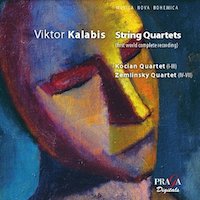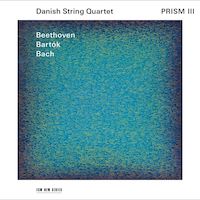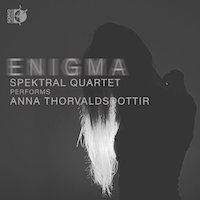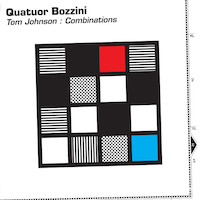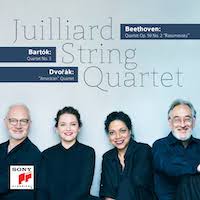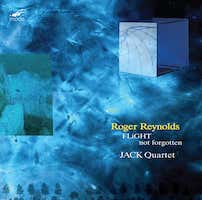String Theory 38: Nineteen String Quartets
|
Grant Chu Covell [July 2022.]
Viktor KALABIS: String Quartet No. 1, Op. 6 (1949)1; String Quartet No. 2, Op. 19 (1962)2; String Quartet No. 3, Op. 48 (1977)3; String Quartet No. 4, Op. 62, “Tribute to J.S. Bach” (1983-84)4; String Quartet No. 5, Op. 63, “In memory of Marc Chagall” (1984)5; String Quartet No. 6, Op. 68, “In memory of Bohuslav Martinů” (1987-88)6; String Quartet No. 7, Op. 76 (1993)7. Kocian Quartet1,2,3: Pavel Hůla, Miloš Černý (vln), Zbyněk Paďourek (vla), Václav Bernášek (vlc), Zemlinsky Quartet4,5,6,7: František Souček, Petr Střížek (vln), Petr Holman (vla), Vladimír, Fortin (vlc). Praga PRD 250 262 (2 CDs) (www.pragadigitals.com). Two quartets deliver a seven-installment series by Kalabis (1923-2006), and it’s hard not to note that the Zemlinsky Quartet who takes the last four has an advantage simply because the music is more secure. The Zemlinsky also seems to push tempos and dynamics a bit more than their Kocian peers. No. 1 is a reassuring hybrid of Beethoven and Bartók, sounding familiar, like a cousin only seen at weddings and funerals. Nos. 2 and 3 are more dissonant and harder to like, whereas No. 4 offers gallant expression in a Berg / Bartók hybrid. A familiar Bach chorale from the St. Matthew Passion and elsewhere (“O Haupt voll Blut und Wunden”) appears. Unexpectedly, I heard more Martinů in No. 5 than No. 6. The Seventh Quartet is an animated single movement.
“Prism III.” Ludwig van BEETHOVEN: String Quartet No. 14 in C-sharp minor, Op. 131 (1826). Bela BARTÓK: String Quartet No. 1, Op. 7, Sz. 40 (1909). J.S. BACH: Fugue in C-sharp minor from the Well-Tempered Clavier, Book 1, BWV 849 (1722; arr. Emanuel Aloys FÖRSTER). Danish String Quartet: Frederik Øland, Rune Tonsgaard Sørensen (vln), Asbjørn Nørgaard (vla), Fredrik Schøyen Sjölin (vlc). ECM 2563 (1 CD) (www.ecmrecords.com). The Danish String Quartet stands tall among so many other groups because they are tightly integrated and execute cohesively. They are not a reedy ensemble. Can Op. 131 be anything but erudite and capricious? The quartet starts in one place with its craggy fugue and ends in another, and the Danes are up to the trying journey, but perhaps their expressiveness at the start is not matched by the severity at the end. The Beethoven is paired with a most convincing rendition of Bartók’s First. This is the best Bartók No. 1 I have heard in a long time. The Danes offer this quartet as if it were the only one Bartók had ever written and play as if it must encapsulate all varieties of expression, folk music and modernism. This is the third installment of a series which pairs one of the late Beethoven quartets with a later quartet as well as a Bach fugue in a related key. A bit of magic is involved here: the C-sharp minor fugue necessitates five voices and so the required second viola line was added later.
“Enigma.” Anna THORVALDSDOTTIR: Enigma (2019). Spektral Quartet: Maeve Feinberg, Clara Lyon (vln), Doyle Armbrust (vla), Russell Rolen (vlc). Sono Luminus DSL-92250 (1 SACD) (www.sonoluminus.com). It’s easy to argue we’ve heard this before: A string quartet proceeding slowly, dreamily alternating broad chorales, microtonal buzzing, grating noises suggesting crackling glaciers, and sliding effects like Sculthorpe’s sea gulls. The scale (28:28) is not immense, but it does permit a gradual unfolding, or multiple glances across a wide landscape. We are missing an accompanying video by Sigurður Guðjónsson meant for planetariums. The notes suggest this is a pandemic piece, something written during these times of uncertainty, and that Thorvaldsdottir has included precise details as well as tapped into something universal. Hyperbole aside, the work varies considerably, and the Spektral Quartet sounds mighty fine (they are disbanding at this season’s conclusion!). All said, it really doesn’t matter what this is about.
“Combinations.” Tom JOHNSON: Combinations for String Quartet (2003); Tilework for String Quartet (2003); Four-Note Chords in Four Voices (2009); Formulas for String Quartet (1994). Quatuor Bozzini: Alissa Cheung, Clemens Merkel (vln), Stéphanie Bozzini (vla), Isabelle Bozzini (vlc). Collection QB CQB 2230 (1 CD) (www.quatuorbozzini.ca). Should you have started this disc and not noticed that the Quatuor Bozzini can be incredibly accurate, then III of the five Combinations should blow you away with its magnetic precision. In other Johnson pieces it may be more obvious what’s being varied (for example, in II it’s a single pitch played by different permutations of four), but here it is easy to completely lose the thread. Johnson’s note for Tilework may not help: “Tilework for String Quartet is a compilation of all the ways one can tile a line of 12 points by overlapping a single six-note rhythm. The four musicians play these rhythms in canon for 10 minutes in a rapid music requiring great precision.” Each possible rhythm is introduced in unison, then the players proceed through the short canon where they, miraculously, never play simultaneously. In 15 parts, Four-Note Chords in Four Voices cycles slowly through four-note chords in four voices. Formulas is in eight parts, each section following a controlled logical sequence, often obscure. This may be the most sober Johnson program I have heard.
Ludwig van BEETHOVEN: String Quartet in E minor, Op. 59, No. 2 (1806). Béla BARTÓK: String Quartet No. 3, Sz. 85 (1927). Antonín DVOŘÁK: String Quartet in F Major, Op. 96, “American” (1893). Juilliard String Quartet: Areta Zhulla, Ronald Copes (vln), Roger Tapping (vla), Astrid Schween (vlc). Sony 19439858752 (1 CD) (www.sonyclassical.de). Frankly, I could do with a multi-year respite from the American quartet, but I have a soft spot for the Juilliard’s Beethoven and this Op. 59, No. 2, is a wonderful performance. This Juilliard combination tells an engaging and exciting story with the second Razumovsky. I also have a fondness for the Juilliard’s Bartók, and this version is more mercurial, even menacing, than the 1965 recording (Columbia Masterworks D3S 717) which was my mainstay for decades. The glissandos scattered around are delivered with such relish. Hands down, the Juilliard provides convincing interpretations tempered by experience. As for the American, well, it is nice to hear Tapping’s solo in one of his last recordings. It’s a vigorous Dvořák, and one can almost hear the wind sweeping over the fields in Spillville, Iowa.
“Roger Reynolds at 85, Vol. 1: String Quartets.” Roger REYNOLDS: FLiGHT (2012-16); not forgotten (2007-10). JACK Quartet: Cristopher Otto, Austin Wulliman (vln), John Pickford Richards (vla), Jay Campbell (vlc). mode records 326 (1 CD) (www.moderecords.com). Reynolds’ obstruse designs result in complexities not unlike Ferneyhough or Xenakis. These recent string quartets are choleric, incredibly detailed, and maximally varied. Even though they explore stringed instrument capabilities, they do not fit cleanly into the modern string quartet as a genre. FLiGHT seems to make more sense on repeated listening. The string quartet is part of a larger multi-media event which responds to man’s desire to fly, essentially myths and stories about flying, as well as experiences real and imagined, aloft in balloons, planes, etc. If FLiGHT is irreverent and unmusical, and so astonishingly unpredictable, not forgotten is anchored with solos and remembrances (of Takemitsu, Carter and Xenakis, and of places Reynolds has visited: e.g.: Giverny, Ryoanji). In the Iannis movement, Reynolds briefly touches upon Tetras; in Elliott we hear the solo cello countering granitic chords reflecting a similar moment in Carter’s Third Quartet. The instrumental solos (each player gets one) trigger the movements which follow and can start before the prior movement completes (the central four movements can be played in any order between the prescribed bookending movements). As always, JACK plays like they own the place: FLiGHT was written for them (and with them), not forgotten was premiered by the Arditti Quartet.
[Previous Article:
Piano Factory 31. / (Dis)Arrangements 15.]
[Next Article:
Maestro di Suoni e Silenzi: Necessary Nono 6.]
|
